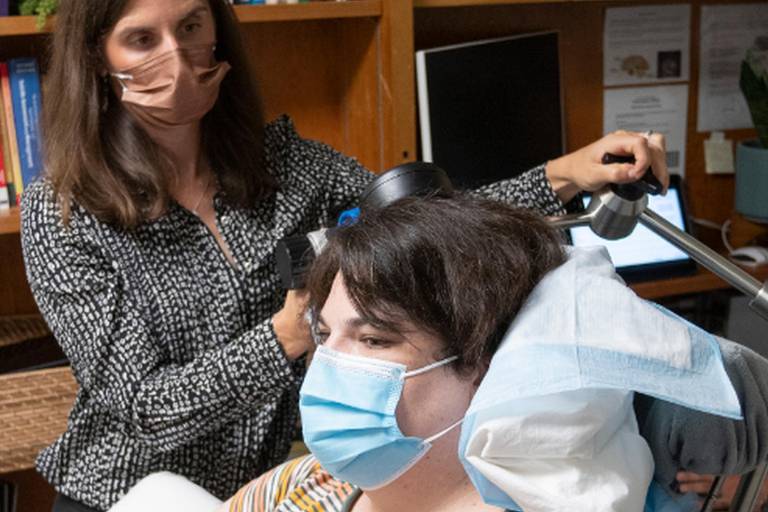American scientists have taken a new step towards discovering and treating depression Severe when an electrical implant was placed in a patient’s skull and attached to her brain.
Sarah, 36, received the device over a year ago and says her life has changed.
The implant, about the size of a matchbox, is always “on” but only gives an electrical pulse when it feels like Sarah needs it.
The pilot study was described in the scientific journal Nature Medicine.
The researchers, from the University of California, San Francisco, in the US, note that it is too early to say whether the device can help other patients with hard-to-treat depression, but say they are optimistic and plan more. the exams.
Sarah is the first person to do the experimental treatment.
She has gone through a series of failed treatments, including antidepressants and electroconvulsive therapy in recent years.
The surgery may seem daunting, but Sarah said the prospect of getting “any kind of relief” is better than what she was experiencing.
“I have exhausted all possible treatment options.”
“My daily life became very restricted. I felt tortured every day. I could barely move or do anything.”
The surgery involved making small holes in his skull to fit wires that would monitor and stimulate his brain.
The implant, which contained the battery and pulse generator, was tucked into the bone, under her scalp and hair.
The operation took a whole day and was performed under general anaesthesia, which meant that Sarah was unconscious the whole time.
She says she felt so happy when she woke up.
“When the implant was first placed, my life immediately took a turn. My life was interesting again.”
In a few weeks, suicidal thoughts disappeared.”
“When I was in the depths of depression, all I saw was the downside of things.”
A year later, Sarah is still doing well, with no side effects.
“The device kept my depression in check, allowing me to return to my best condition and rebuild a life worth living.”
Sarah says she doesn’t feel the device because it’s sending electrical impulses, but says, “I can probably say in 15 minutes it went off because of the feeling of alertness, energy or positivity I’m feeling.”
How it works
Researcher Catherine Skangos, a psychologist at the university, said the innovation was made possible by identifying “depressive circuits” in Sarah’s brain.
“We found a spot, an area called the ventral striatum, where stimulation eliminates your persistent feeling of depression.”
We also found a region of brain activity in the amygdala that can predict when your symptoms are most severe.
Scientists say more research is needed to test the experimental treatment and determine if it can help more people with major depression and possibly other conditions as well.
personalized treatment
“We need to look at how these circuits differ between patients and repeat this work over and over again,” said Skangos, who has enrolled two more patients in the trial and hopes to recruit nine more.
“And we need to know if the individual’s biomarkers or brain circuits change over time as treatment continues.”
“We didn’t know if we would be able to cure her depression, because it was so serious.”
“So, in that sense, we’re very excited about it. It’s the kind of study that’s very much in demand in our field right now.”
“To be clear, this is not evidence of the effectiveness of this treatment,” warns Edward Chang, the neurosurgeon who installed the device.
“It’s really just the first evidence that this works for someone and we have a lot of work ahead to validate these results. We need to see if this is something that really continues.”
Professor Jonathan Roiser, a neuroscientist at University College London, UK, said: “Although this type of highly invasive procedure is only used in the most severe patients with intractable symptoms, it is an exciting step given the stimulant nature of it.”
“It is likely that if it were tested in other patients, different recording and stimulation sites would be required, as the cerebral circuits for symptoms are likely to differ between individuals.”
“Because there was only one patient and no control conditions, it remains to be seen if these promising results hold up in clinical trials.”

“Hardcore beer fanatic. Falls down a lot. Professional coffee fan. Music ninja.”


![[VÍDEO] Elton John’s final show in the UK has the crowd moving](https://www.tupi.fm/wp-content/uploads/2023/06/Elton-John-1-690x600.jpg)



More Stories
The Director of Ibict receives the Coordinator of CESU-PI – Brazilian Institute for Information in Science and Technology
A doctor who spreads fake news about breast cancer is registered with the CRM of Minas
The program offers scholarships to women in the field of science and technology